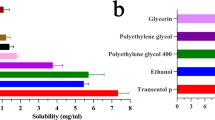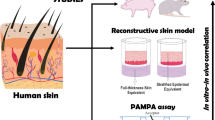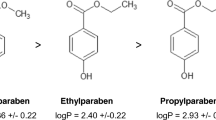Abstract
Type of biological membrane used in skin permeation experiment significantly affects skin permeation and deposition potential of tested formulations. In this study, a comparative study has been carried out to evaluate the potential of a synthetic membrane (Strat-M™) with rat, human, and porcine ear skin to carry out skin permeation study of nanoformulations of a high molecular weight drug, amphotericin B. Results demonstrated that the permeation of this high molecular weight drug through Strat-M™ showed close similitude to human skin. Value of correlation coefficient (R2) of log diffusion between Strat-M™ and human skin was found to be 0.99 which demonstrated the similarities of Strat-M™ membrane to the human skin. In similarity factor analysis, the value of f2 was also found to be 85, which further demonstrated the similarities of Strat-M™ membrane to human skin. Moreover, scanning electron microscopy (SEM), transmission electron microscopy (TEM), and Brunauer-Emmett-Teller (BET) analysis of synthetic and biological membranes depicted almost similar morphological features (thickness, pore size, surface morphology, and diameter) of synthetic membrane with human skin. The results of the study demonstrated Strat-M™ as a better alternative to carry out skin permeation experiment due to the consistent results, reproducibility, easy availability, and minimum variability with human skin.













Similar content being viewed by others
References
Coceani N, Colombo I, Grassi M. Acyclovir permeation through rat skin: mathematical modelling and in vitro experiments. Int J Pharm. 2003;254(2):197–210. https://doi.org/10.1016/S0378-5173(03)00028-0.
Morimoto Y, Hatanaka T, Sugibayashi K, Omiya H. Prediction of skin permeability of drugs: comparison of human and hairless rat skin. J Pharm Pharmacol. 1992;44:634–9.
Kumar P, Singh SK, Mishra DN, Girotra P. Enhancement of ketorolac tromethamine permeability through rat skin using penetration enhancers: an ex-vivo study. Int J Pharm Investig. 2015;5(3):142–6. https://doi.org/10.4103/2230-973X.160850.
Summerfield A, Meurens F, Ricklin ME. The immunology of the porcine skin and its value as a model for human skin. Mol Immunol. 2015;66:14–21.
Jacobi U, Kaiser R, Toll S, Mangelsdorf H, Audring N, Otberg W, et al. Porcine ear skin: an in vitro model for human skin. Skin Res Technol. 2007;13(1):19–24. https://doi.org/10.1111/j.1600-0846.2006.00179.x.
Cilurzo F, Minghetti P, Sinico C. Newborn pig skin as model membrane in in vitro drug permeation studies: a technical note. AAPS Pharm Sci Tech. 2007;8(4):97–100. https://doi.org/10.1208/pt0804094.
Dick IP, Scott RC. Pig ear skin as an in-vitro model for human skin permeability. J Pharm Pharmacol. 1992;44(8):640–5. https://doi.org/10.1111/j.2042-7158.1992.tb05485.x.
Boakye CH, Patel K, Singh M. Doxorubicin liposomes as an investigative model to study the skin permeation of nanocarriers. Int J Pharm. 2015;489(1-2):106–16. https://doi.org/10.1016/j.ijpharm.2015.04.059.
Barbero AM, Frasch HF. Pig and guinea pig skin as surrogates for human in vitro penetration studies: a quantitative review. Toxicol in Vitro. 2009;23:1–13.
Joshi V, Brewster D, Colonero P. Transdermal diffusion. In vitro diffusion studies in transdermal research: a synthetic membrane model in place of human skin. Drug Dev Delivery. 2012;12:40–2.
Uchida T, Kadhum WR, Kanai S, Todo H, Oshizaka T, Sugibayashi K. Prediction of skin permeation by chemical compounds using the artificial membrane, Strat-M™. Eur J Pharm Sci. 2015;67:113–8. https://doi.org/10.1016/j.ejps.2014.11.002.
El-On J, Jacobs GP, Witztum E, Greenblatt CL. Development of topical treatment for cutaneous leishmaniasis caused by Leishmania major in experimental animals. Antimicrob Agents Chemother. 1984;26(5):745–51. https://doi.org/10.1128/AAC.26.5.745.
Santos CM, Oliveira RB, Arantes VT, Caldeira LR, Oliveira MC, Egito ES, et al. Amphotericin B-loaded nanocarriers for topical treatment of cutaneous leishmaniasis: development, characterization and in vitro skin permeation studies. Biomed Nanotech. 2012;8:322–9.
Kaur L, Jain SK, Manhas RK, Deepika S. Nanoethosomal formulation for skin targeting of amphotericin B: an in vitro and in vivo assessment. J Liposome Res. 2014;25:294–307.
Kaur L, Jain SK, Singh K. Vitamin E TPGS based nanogel for skin targeting of high molecular weight anti-fungal drug: development, in vitro and in vivo assessment. RSC Adv. 2015;5(66):53671–86. https://doi.org/10.1039/C5RA08374E.
Jain S, Jain N, Bhadra D, Tiwary AK, Jain NK. Transdermal delivery of an analgesic agent using elastic liposomes: preparation, characterization and performance evaluation. Curr Drug Deliv. 2005;2(3):223–33. https://doi.org/10.2174/1567201054368020.
Puri R, Jain S. Ethogel topical formulation for increasing the local bioavailability of 5-fluorouracil: a mechanistic study. Anti-Cancer Drugs. 2012;23(9):923–34. https://doi.org/10.1097/CAD.0b013e3283534051.
Mall JP, Patel PC, Verma JN. Simultaneous high performance liquid chromatographic estimation of amphotericin b in dry injection dosage form. Pharm Rev. 2009:141–2.
Moore JW, Flanner HH. Mathematical comparison of dissolution profiles. Pharm Tech. 1996;20:64–74.
John H, Barbara DA, David A, Beth A, Steven DB, Vishnu C. Clinical laboratory standard institute. Reference method for broth antifungal susceptibility testing of filamentous fungi. Approved standard, 2nd edition. CLSI document M38-A2 CLSI, Wayne: CLSI; 2008.
Maebashi K, Itoyama T, Uchida K, Suegara N, Yamaguchi H. A novel model of cutaneous candidiasis produced in prednisolone-treated guinea-pigs. J Med Vet Mycol. 1994;32(5):349–59. https://doi.org/10.1080/02681219480000471.
Sulaiman SM, Rajashekhar G, Prakash PJ, Singh DS, Saleem C. Immunoprophylactic activity of immunol, a polyherbal formulation against dexamethasone induced immunosuppression in rats. J Pharm Toxicol. 2010;5:275–87.
Ramasamy T, Khandasami U, Ruttala H, Shanmugam S. Development of solid lipid nanoparticles enriched hydrogels for topical delivery of anti-fungal agent. Macromol Res. 2012;20(7):682–92. https://doi.org/10.1007/s13233-012-0107-1.
Prasanthi D, Lakshmi PK. Effect of chemical enhancers in transdermal permeation of alfuzosin hydrochloride. ISRN Pharm. 2012;965280
Shakeel F, Baboota S, Ahuja A, Ali J, Shafiq S. Skin permeation mechanism and bioavailability enhancement of celecoxib from transdermally applied nanoemulsion. J Nanobiotech. 2008;6(1):8. https://doi.org/10.1186/1477-3155-6-8.
Serrano DR, Hernandez L, Fleire L, Alvarez I, Montoya A, Ballesteros MP, et al. Hemolytic and pharmacokinetic studies of liposomal and particulate amphotericin B formulations. Int J Pharm. 2013;44:38–46.
Shiow F, Rouse J, Sanderson D, Eccleston G. A comparative study of transmembrane diffusion and permeation of ibuprofen across synthetic membranes using Franz diffusion cells. Pharmaceutica. 2010;2:209–23.
Jung EC, Maibach HI. Animal models for percutaneous absorption. J Appl Toxicol. 2015;35:1–10.
Gray GM, Yardley HJ. Lipid compositions of cells isolated from pig, human, and rat epidermis. J Lipid Res. 1975;16:434–40.
Kim KJ, Dickson MR, Fane AG, Fell CJ. Electron microscopy in synthetic polymer membrane research. J Microsc. 1991;162(3):403–13. https://doi.org/10.1111/j.1365-2818.1991.tb03150.x.
Scott RC, Corrigan MA, Smith F, Mason H. The influence of skin structure on permeability: an intersite and interspecies comparison with hydrophilic penetrants. J Invest Dermacol. 1990;96(6):921–5. https://doi.org/10.1111/1523-1747.ep12475447.
Milewski M, Brogden NK, Stinchcomb AL. Current aspects of formulation efforts and pore lifetime related to microneedle treatment of skin. Expert Opin Drug Deliv. 2010;7:617–29.
Niranjan HP, Padmaja N, Priyanka BV. Study of onychomycosis at a tertiary care hospital in South India. J Evol Med Dent Sci. 2012;1:823–9.
Rosso JQ. The role of topical antifungal therapy for onychomycosis and the emergence of newer agents. J Clin Aesthet Dermatol. 2014;7(7):10–8.
Peerapur BV, Inamdar AC, Pushpa PV, Srikant B. Clinicomycological study of dermatophytosis in Bijapur. Indian J Med Microbiol. 2004;22(4):273–4.
Weitzman I, Summerbell R. The dermatophytes. Clin Microbiol. 1995;8:240–59.
Bhatia VK, Sharma PC. Epidemiological studies on Dermatophytosis in human patients in Himachal Pradesh, India. Spring. 2014;3(1):134. https://doi.org/10.1186/2193-1801-3-134.
Dias MFR, Santos MVP, Filho FB, Amorim AG, Schechtman RC, Azulay DR. Update on therapy for superficial mycoses: a review article part 1. An Bras Dermatol. 2013;88:764–74.
Yenisehirli G, Tuncoglu E, Yenisehirli A, Bulut Y. In vitro activities of antifungal drugs against dermatophytes isolated in Tokat, Turkey. Int J Dermatol. 2013;52(12):1557–60. https://doi.org/10.1111/ijd.12100.
Lavasanifar A, Samuel J, Sattari S, Kwon GS. Block copolymer micelles for the encapsulation and delivery of amphotericin B. Pharm Res. 2002;19:418–22.
Ridy MS, Yehia SA, Kassem MA, Mostafa DM, Nasr EA, Asfour MH. Niosomal encapsulation of ethambutol hydrochloride for increasing its efficacy and safety. Drug Deliv. 2015;22(1):21–36. https://doi.org/10.3109/10717544.2013.868556.
Kumar P, Lakshmi YS, Golla K, Kondapi AK. Improved safety, bioavailability and pharmacokinetics of zidovudine through lactoferrin nanoparticles during oral administration in rats. PLoS One. 2015;10(10):e0140399. https://doi.org/10.1371/journal.pone.0140399.
Acknowledgements
One of authors Ms. Lakhvir Kaur is thankful to DST, New Delhi, for providing senior research fellowship under INSPIRE scheme. The authors are thankful to UGC, New Delhi for providing the financial assistance [scheme No. 42-673/2013(SR)]
Author information
Authors and Affiliations
Contributions
All authors contributed in design of this manuscript in one or other aspects.
Corresponding author
Ethics declarations
All animal experimentations were performed after approval by the Institutional Animal Ethics Committee of Guru Nanak Dev University, Amritsar (Registration no. 226/PO/Re/S/2000/CPCSEA).
Conflict of Interest
The authors declare that they have no conflicts of interest.
Rights and permissions
About this article
Cite this article
Kaur, L., Singh, K., Paul, S. et al. A Mechanistic Study to Determine the Structural Similarities Between Artificial Membrane Strat-M™ and Biological Membranes and Its Application to Carry Out Skin Permeation Study of Amphotericin B Nanoformulations. AAPS PharmSciTech 19, 1606–1624 (2018). https://doi.org/10.1208/s12249-018-0959-6
Received:
Accepted:
Published:
Issue Date:
DOI: https://doi.org/10.1208/s12249-018-0959-6




